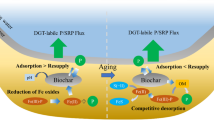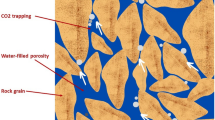Abstract
Hydrothermally altered rocks are frequently encountered when tunnels are constructed in Hokkaido, Japan. High concentraions of hazardous elements, such as arsenic (As), are often released from these rocks into the surrounding environments. Therefore, the rocks are considered potentially hazardous waste. This article describes the effects of water content and oxygen (O2) concentration in relation to additional layer(s), i.e., surface covering and bottom adsorption layers, on As leaching by using laboratory columns with water content and O2 concentration sensors. The results show that the use of additional layer(s) has a significant effect on lowering As migration. This was due not only to the adsorption capacity of As by the adsorption layer but also to the water content and O2 concentration inside the rock layer. The accumulation of pore water was increased in the rock layer in cases with additional layer(s), which resulted in lower O2 concentration in the rock layer. Consequently, the leaching of As by the oxidation of As-bearing minerals in the rock layer was reduced. Moreover, a longer water-resident time in the rock layer may induce precipitation of Fe oxy-hydroxide/oxide. These results suggest that the geochemical conditions of the rock layer affect As leaching and migration.









Similar content being viewed by others
References
Aachib, M., Mbonimpa, M., & Aubertin, M. (2004). Measurement and prediction of the oxygen diffusion coefficient in unsaturated media, with applications to soil covers. Water, Air, & Soil Pollution, 156(1), 163–193.
Appelo, C. A. J., & Postma, D. (2005). Geochemistry, groundwater and pollution (2nd ed.). London: A.A. Blkema.
Bornstein, J., Hedstrom, W. E., & Scott, F. R. (1980). Oxygen diffusion rate relationships under three soil conditions. Technical Bulletin, 98, 1–12.
Chandra, A. P., & Gerson, A. R. (2010). The mechanisms of pyrite oxidation and leaching: a fundamental perspective. Surface Science Reports, 65(9), 293–315.
Chen, C. J., Chen, C. W., Wu, M. M., & Kuo, T. L. (1992). Cancer potential in liver, lung, bladder and kidney due to ingested inorganic arsenic in drinking water. British Journal of Cancer, 66(5), 888–892.
Cornelis, G., Johnson, C. A., Gerven, T. V., & Vandecasteele, C. (2008). Leaching mechanisms of oxyanionic metalloid and metal species in alkaline solid wastes: a review. Applied Geochemistry, 23(5), 955–976.
Deutsch, W. J. (1997). Groundwater geochemistry: fundamentals and applications to contamination. Florida: Lewis.
Donato, P., Mustin, C., Benoit, R., & Erre, R. (1993). Spatial distribution of iron and sulphur species on the surface of pyrite. Applied Surface Science, 68(1), 81–93.
Dzombak, D. A., & Morel, F. M. M. (1990). Surface complexation modeling: hydrous ferric oxide. New York: Wiley.
Foster, A. L., Brown, G. E., Jr., Tingle, T. N., & Parks, G. A. (1998). Quantitative arsenic speciation in mine tailings using X-ray absorption spectroscopy. American Mineralogist, 83, 553–568.
Ghosh, M. M., & Yuan, J. R. (1987). Adsorption of inorganic arsenic and organoarsenicals on hydrous oxides. Environmental Progress, 6(3), 150–157.
Gupta, A. K., & Gupta, M. (2005). Synthesis and surface engineering of iron oxide nanoparticles for biomedical applications. Biomaterials, 26(18), 3995–4021.
Katsumi, T., Benson, C. H., Foose, G. J., & Kamon, M. (2001). Performance-based design of landfill liners. Engineering Geology, 60(1-4), 139–148.
Klerk, R. J. D., Jia, Y., Daenzer, R., Gomez, M. A., & Demopoulos, G. P. (2012). Continuous circuit co-precipitation of arsenic (V) with ferric iron by lime neutralization: process parameter effects on arsenic removal and precipitate quality. Hydrometallurgy, 111–112, 65–72.
Lui, Z., & Dreybrodt, W. (1997). Dissolution kinetics of calcium carbonate minerals in H2O–CO2 solutions in turbulent flow: the role of the diffusion boundary layer and the slow reaction H2O + CO2 ‹–› H+ + HCO3 −. Geochimica et Cosmochimica Acta, 61, 2879–2889.
Ministry of Land Infrastructure Transport and Tourism Japan (2010). Status of water resources in Japan. http://www.mlit.go.jp/common/001121771.pdf, Accessed 1 September 2016.
Morse, W. J., Arvidson, S. R., & Luttge, A. (2007). Calcium carbonate formation and dissolution. Chemical Reviews, 107(2), 342–381.
Neira, J., Ortiz, M., Morales, L., & Acevedo, E. (2015). Oxygen diffusion in soils: understanding the factors and processes needed for modeling. Chilean Journal of Agricultural Research, 75, 35–44.
O’day, P. A., Vlassopoulos, D., Root, R., & Rivera, N. (2004). The influence of sulfur and iron on dissolved arsenic concentrations in the shallow subsurface under changing redox conditions. Proceedings of the National Academy of Sciences, 101(38), 13703–13708.
Pirajno, F. (2009). Hydrothermal processes and mineral systems. The Natherlands: Springer Science.
Ruiping, L., Xing, L., Shengji, X., Yanling, Y., Rongcheng, W., & Guibai, L. (2007). Calcium-enhanced ferric hydroxide co-precipitation of arsenic in the presence of silicate. Water Environment Research, 79(11), 2260–2264.
Safiullah, S., Kabir, A., Hasan, K., & Rahman, M. M. (2004). Comparative study of adsorption-desorption of arsenic on various arsenic removing materials. Journal of Bangladesh Academy of Sciences, 28(1), 27–34.
Savage, K. S., Tingle, T. N., O’day, P. A., Waychunas, G. A., & Bird, D. K. (2000). Arsenic speciation in pyrite and secondary weathering phases, Mother Lode Gold District, Tuolumne Country, California. Applied Geochemistry, 15(8), 1219–1244.
Schaufuß, A. G., Nesbitt, H. W., Kartio, I., Laajalehto, K., Bancroft, G. M., & Szargan, R. (1998). Reactivity of surface chemical states on fractured pyrite. Surface Science, 411, 321–328.
Smedley, P. L., & Kinniburgh, D. G. (2002). A review of the source, behavior and distribution of arsenic in natural waters. Applied Geochemistry, 17(5), 517–568.
Stumm, W., & Lee, F. (1961). Oxygenation of ferrous iron. Industry and Engineering Chemistry, 53, 143–146.
Tabelin, C. B., & Igarashi, T. (2009). Mechanisms of arsenic and lead release from hydrothermally altered rock. Journal of Hazardous Materials, 169(1-3), 980–990.
Tabelin, C. B., Igarashi, T., & Takahashi, R. (2012a). Mobilization and speciation of arsenic from hydrothermally altered rock in laboratory column experiments under ambient conditions. Applied Geochemistry, 27(1), 326–342.
Tabelin, C. B., Igarashi, T., & Yoneda, T. (2012b). Mobilization and speciation of arsenic from hydrothermally altered rock containing calcite and pyrite under anoxic conditions. Applied Geochemistry, 27(12), 2300–2314.
Tabelin, C. B., Igarashi, T., Arima, T., & Sato, D. (2014). Characterization and evaluation of arsenic and boron adsorption onto geologic materials, and their application in the disposal of excavated altered rock. Geoderma, 213, 163–172.
Takahashi, T., Fujii, K., Igarashi, T., Kaketa, K., & Yamada, N. (2011). Distribution properties and leaching of arsenic by the hydrothermally-altered rocks of Nakakoshi Area, central Hokkaido, Japan. Journal of the Japan Society of Engineering Geology, 52(2), 46–54.
Todd, E. C., Sherman, D. M., & Purton, J. A. (2003). Surface oxidation of pyrite under ambient atmospheric and aqueous (pH = 2 to 10) conditions: electronic structure and mineralogy from X-ray absorption spectroscopy. Geochimica et Cosmochimica Acta, 67(5), 881–893.
Wang, S., & Mulligan, C. N. (2006). Natural attenuation processes for remediation of arsenic contaminated soils and groundwater. Journal of Hazardous Materials, 138(3), 459–470.
Webster, J. G. (1999). Arsenic. In C. P. Marshall & R. W. Fairbridge (Eds.), Encyclopedia of geochemistry (pp. 21–22). London: Chapman Hall.
WHO (World Health Organization) (2011). Guidelines for drinking-water quality. 4th edition.
Acknowledgements
Part of this research was supported by the Japan Society for the Promotion of Science (JSPS) grant-in-aid for scientific research (grant number 26289149).
Author information
Authors and Affiliations
Corresponding author
Rights and permissions
About this article
Cite this article
Tangviroon, P., Hayashi, R. & Igarashi, T. Effects of Additional Layer(s) on the Mobility of Arsenic from Hydrothermally Altered Rock in Laboratory Column Experiments. Water Air Soil Pollut 228, 191 (2017). https://doi.org/10.1007/s11270-017-3295-7
Received:
Accepted:
Published:
DOI: https://doi.org/10.1007/s11270-017-3295-7




